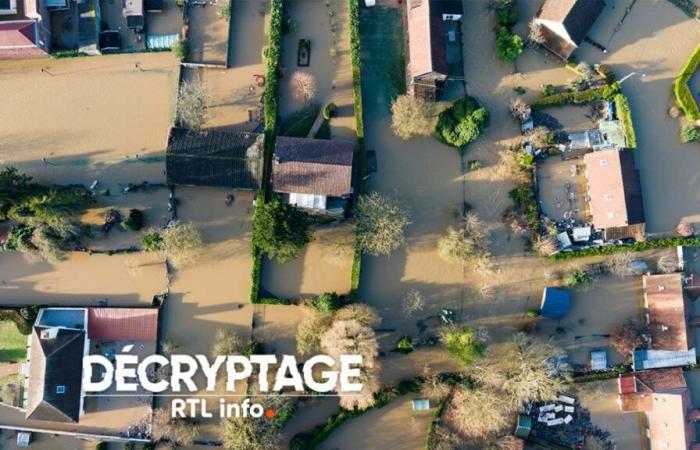Spain has undoubtedly just experienced one of the deadliest rainy episodes in recent decades. Elsewhere in Europe, similar phenomena are occurring, such as the devastating floods of 2021. Is the old continent increasingly exposed to this type of natural disaster?
In recent years, Europe has experienced episodes of floods of unprecedented violence. In July 2021, historic floods particularly affected Germany and Belgium, causing the death of more than 200 people. More recently, in September, Storm Boris caused deadly floods in Central Europe, affecting Romania, Poland, the Czech Republic, Austria and Slovakia, leaving eleven dead and several missing. Recently, France and Italy have also had to face this extreme climatic phenomenon.
Can we therefore say that floods are becoming more and more frequent in Europe? François Massonnet, climatologist at the Catholic University of Louvain, urges caution regarding the conclusions: “It’s clear that we have had three major phenomena in three years, that makes a big impression. But now, if we really want to produce statistics in a robust way, three events like that are very few in fact for a climatic time scale”he explains, adding that for him, attributing an increase in this type of event based on occurrence is “a little bit daring”.
Ocean warming as an amplifying effect
Although the increase in the frequency of these events has not yet been precisely demonstrated, their intensity and impact have indeed increased due to global warming. “When the air is warmer, it can hold more water vapor”indicates the climatologist, recalling that this capacity of the atmosphere to store humidity has been well known to climatologists since 1850. “What will count is the impact of these climatic phenomena, and their impact, we know that it is multiplied by the fact that the air is warmer today than 150 years ago”he emphasizes.
The cold drop, the cause of precipitation, is a meteorological phenomenon where a mass of cold air at altitude is isolated above a region, causing thunderstorms and intense precipitation due to the temperature contrast with the hot air on the surface.
However, this phenomenon alone does not explain the scale of these natural disasters. “On the one hand, there is the triggering event which is the cold drop, for which we necessarily have few observations because they remain quite rare events, but the fact of having three in a row like that , it's true that it rings a bell. On the other hand, there is this phenomenon which is linked to an amplifying factor, namely the fact that the oceans are much warmer than before.explains the UCL expert.
In other words, ocean surface temperatures, two degrees higher on average compared to the 19th century, contribute to intensifying these phenomena by increasing evaporation and therefore humidity in the atmosphere. Combined with warmer air, this water vapor condenses and falls in the form of more violent precipitation. “The question is whether the cold drop that hit Spain recently, Belgium in 2021, or even that linked to storm Boris in Central Europe would have had the same impact 150 years ago. And here we are almost sure the answer is no, because at the time, the surface temperature of the oceans was two degrees lower than today Result? so, certainly intense precipitation, but probably not at the level of what we observed today.”
Disaster areas are areas heavily transformed by human activity, with ultra-concrete soils.
The effects of climate change are not the only factors exacerbating flooding. Urbanization practices and the artificialization of land also worsen the situation. “Disaster areas are areas strongly transformed by human activity, with ultra-concrete soils,” adds François Massonnet. “With methods of agriculture which have transformed the earth to the point of no longer allowing water to easily infiltrate into the soil, and therefore when there are like that 450 millimeters of water per square meter falling in less than 24 hours on floors which are also completely impermeable, the only thing that can happen is what we have seen.”
In some large cities, adaptation infrastructure has been developed, such as storm basins to contain rainwater. However, “we cannot put storm basins all over Spain, just as we cannot put them everywhere in Belgium, it is obviously unrealistic, so those who pay a little bit of the damage in the end are the villages around the large cities, and they do not have all the means of adaptation that are currently developed”, he continues.
What to expect in the coming years?
Climate projections show that the hydrological cycle should be profoundly modified by global warming. Reports from the Intergovernmental Panel on Climate Change (IPCC) predict more intense rainfall events, but also an increase in droughts. “In a warmer world, we expect to have exacerbated hydrological cycles”specifies François Massonnet, which he likens to a “distortion of the hydrological cycle.”
This disruption of the hydrological cycle will result in a slight increase in the total quantity of precipitation, but above all a change in the way in which it is discharged. “Instead of having a month where it rains 3mm every day, you might have 25 days with nothing and three days where 90mm falls all at once, which is the equivalent of a month of rainfall.” Ce “precipitation imbalance” concerns not only Europe, but also the rest of the world.
The three events that have just fallen on our heads really foreshadow what will happen in the decades to come almost everywhere in Europe
As the expert reminds, it is impossible to accurately predict the time and place of the next disaster, because it directly depends on weather hazards. “On the other hand, the science of climate change can predict for us on average how much it is likely to fall in a given place and at a given time, and above all, how much precipitation extremes will increase. And so, yes, in the future, It's clear that we're going to have more. The three events that have just fallen on us really foreshadow what will happen in the decades to come almost everywhere in Europe and elsewhere in the world.”he warns.
Faced with the scale of climate challenges, adaptation becomes crucial. However, according to the specialist, adapting is no longer enough. “We can clearly see that even the means of adaptation put in place are often not up to par because they are modeled on the extremes that we know or have known in the past. And so, we are still in the process of to aim at a target that is moving, if you like, a target that is going a little faster than us.” According to him, it is essential to design adaptations now to face tomorrow's climate extremes, by building, for example, infrastructure such as flood-resistant bridges or storm basins.
“The other way to tackle the problem head on is to focus on mitigation, which consists not of adapting to new extremes, but of acting at the root by reducing our carbon emissions. greenhouse gases.” A reduction which would have the effect of lowering the temperature and returning to a more bearable climate, “with less extreme hydrological events”concludes the climatologist.
Floods natural disaster spain climate change







